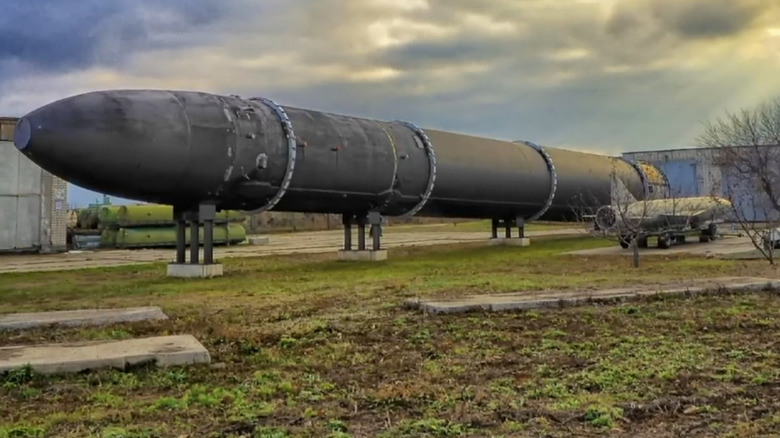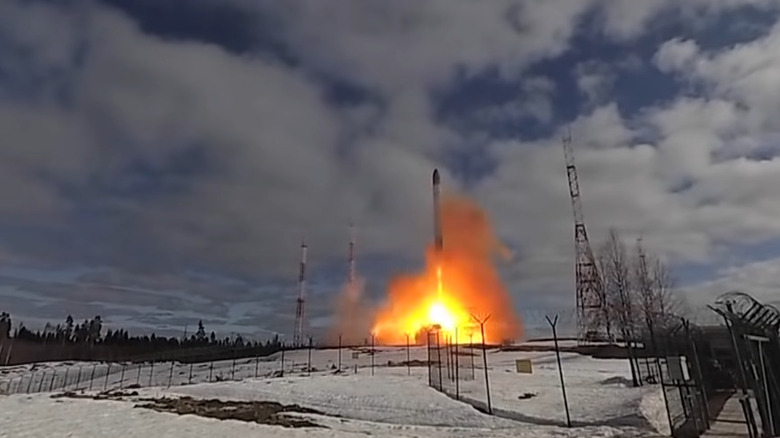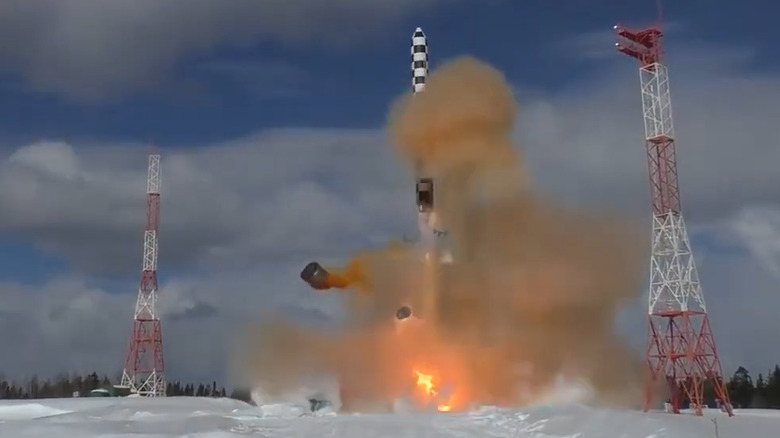What Is Russia's Longest Range Missile And How Far Can It Go?
When discussing the longest-range missiles in the world, you have to mention Russia's RS-28 Sarmat Satan II. Russian President Vladimir Putin claimed it would "strengthen the combat potential of our armed forces," according to ABC, who also quoted him as stating it was advanced enough to overcome all modern anti-missile defenses. The Mirror reported that Putin said other countries should "think twice" about attacking a country with "next generation" warfare technology such as the Satan II. The RS-28 Sarmat Satan II has the longest range of any missile in the world, reportedly capable of reaching nearly 10,000 miles, but is it truly as deadly as Putin claims?
The Satan II is a silo-based, liquid-propellant ballistic missile developed by the Soviet Union starting back in 1964 as the hopeful replacement for the SS-9. Flight tests began in 1973 and the first versions were considered operational by 1975, reportedly reaching distances of 6,200 to 10,000 miles. The fourth version was released in 1979, followed by the fifth and sixth versions, which entered combat by 1988. The earlier versions have since been retired, leaving 46 operational RS-28 Sarmat Satan II missiles by 2016.
How powerful is Russia's Satan II missile?
The RS-28 Sarmat Satan II is quite threatening based on size alone, at 116 feet long and 220 tons. Russia claimed that a single Satan II could carry 16 individual nuclear warheads, but the estimate is at 10 or so. Each of these can be programmed to pinpoint separate targets. Of course, a missile of this size traveling up to 10,000 miles sounds completely devastating, but it's only as good as its ability to penetrate other countries' defenses.
In an early test, Putin claimed that the RS-28 Sarmat Satan II is capable of "overcoming all modern means of anti-missile defense," per Live Science. Military expert Viktor Litovkin stated in 2018 that the treaty between the USSR and the USA was because the United States was afraid of the missile due to its ability to get past defenses and have each nuclear block chase down an individual target. "The warheads flew to the target in a cloud of false elements, masking the fighting blocks themselves — metal trimmings, balloons covered with metal glitters, and other metalized debris that fused into a single large spot on the screen of the radar from which it was impossible to distinguish real nuclear blocks and intercept them with an anti-missile system," Litovkin said.
Russia's Satan II missile test results don't worry the US
However, the United States has not admitted to being fearful of the Satan II. In 2022, Pentagon Press Secretary John Kirby stated that the missile was "not deemed to be a threat" to other countries, including Julian Lewis, the chairman of the U.K. Parliament's intelligence and security committee, told the U.K. Telegraph that the missile "makes absolutely no difference" to nuclear deterrent submarines.
After a successful test that year led to Russia announcing the arrival of 50 new missiles, a test in 2023 was a massive failure. This was the fourth failed test, which left a massive crater in Plesetsk, Russia, where it was supposed to launch. "By all indications, it was a failed test. It's a big hole in the ground," said Pavel Podvig, who runs the Russian Nuclear Forces project. "There was a serious incident with the missile and the silo." The failure likely happened soon after ignition. While the RS-28 Sarmat Satan II is meant to reach far-off countries like the U.K. and U.S. — which would only take 30 minutes — it doesn't seem to be concerning Russia's enemies at the moment, even with new tests that claim to be more successful.


